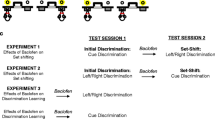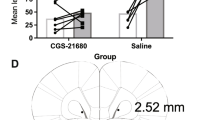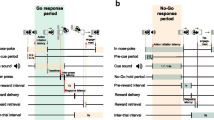Abstract
Rationale
Previous evidence suggests that manipulation of forebrain dopamine (DA) systems may impair the use of conditional information to inform goal-directed performance, and this may be related to impairments in the ability to use task-setting cues in schizophrenia.
Objective
To investigate, using the indirect DA agonist d-amphetamine and the D1/D2 receptor antagonist α-flupenthixol, the influence of DAergic manipulation on discrimination performance that requires the use of conditional information to inform goal-directed performance.
Methods
Both instrumental and Pavlovian conditional discriminations were employed in which rats learned to respond appropriately according to the presence of auditory conditional stimuli, and results from these experiments were contrasted with a control Pavlovian-instrumental transfer task.
Results
Experiment 1 showed a disruption of instrumental conditional discrimination performance by d-amphetamine at 1.5 mg/kg and attenuation of correct responding following 1.0 mg/kg. Disruption with both doses was observed in experiment 2 using a conditional discrimination based on Pavlovian, conditioned responding. Results from a control Pavlovian-instrumental transfer task (experiment 3) revealed that d-amphetamine (0.5, 1.0 and 1.5 mg/kg) did not have any detrimental effect on subjects’ basic sensory, motor or motivational processes. Experiment 4 showed that d-amphetamine disruption of instrumental conditional discrimination was attenuated by pre-treatment with the D1/D2 receptor antagonist α-flupenthixol.
Conclusion
These results demonstrate that tasks dependent on conditional relationships are highly sensitive to manipulation of DAergic systems.




Similar content being viewed by others
References
Arnsten AFT (1998) Catecholamine modulation of prefrontal cortical cognitive function. Trends Cogn Sci 2:436–447
Arnsten AF, Goldman-Rakic PS (1998) Noise stress impairs prefrontal cortical cognitive function in monkeys: evidence for a hyperdopaminergic mechanism. Arch Gen Psychiatry 55:362–368
Barch DM, Cohen JD, Servan-Schreiber D, Ganguli R (1995) The stability and interrelationships of CPT-AX and Stroop performance in schizophrenia. Biol Psychiatry 37:634
Barch DM, Carter CS, Braver TS, Sabb FW, MacDonald A, Noll DC, Cohen JD (2001) Selective deficits in prefrontal cortex function in medication-naïve patients with schizophrenia. Arch Gen Psychiatry 58:280–288
Cohen JD, Servan-Schreiber D (1992) Context, cortex, and dopamine: a connectionist approach to behavior and biology in schizophrenia. Psychol Rev 99:45–77
Cohen RM, Semple WE, Gross M, Mordahl TE, Holcomb HH, Dowling MS, Pickar D (1988) The effect of neuroleptics on dysfunction in a prefrontal substrate of sustained attention in schizophrenia. Life Sci 43:1141–1150
Cohen JD, Dunbar K, McClelland JL (1990) On the control of automatic processes: a parallel distributed processing account of the Stroop effect. Psychol Rev 97:332–361
Cornblatt BA, Lenzenweger MF, Erlenmeyer-Kimling L (1989) A continuous performance test, identical pairs version. II. Contrasting attentional profiles in schizophrenic and depressed patients. Psychiatry Res 29:65–85
Cousins MS, Wei W, Salamone JD (1994) Pharmacological characterization of performance on a concurrent lever pressing/feeding choice procedure: effects of dopamine antagonist, cholinomimetic, sedative and stimulant drugs. Psychopharmacology (Berlin) 116:529–537
Dickinson A, Smith J, Mirenowicz J (2000) Dissociation of Pavlovian and instrumental incentive learning under dopamine agonists. Behav Neurosci 114:468–483
Evenden JL, Dogget SJ (1989) A comparison of the effects of amphetamine, apomorphine and white noise on response switching in the rat. Psychopharmacology 97:238–242
Fletcher PJ, Higgins GA (1997) Differential effects of ondansetron and alpha-flupenthixol on responding for conditioned reward. Psychopharmacology 134:64–72
Good M, Honey RC (1991) Conditioning and contextual retrieval in hippocampal rats. Behav Neurosci 105:499–509
Howell DC (1992) Statistical methods in psychology, 3rd edn. California Duxbury, Belmont
Javitt DC, Shelley A-M, Silipo G, Lieberman JA (2000) Deficits in auditory and visual context-dependent processing in schizophrenia: defining the pattern. Arch Gen Psychiatry 57:1131–1137
Killcross AS, Everitt BJ, Robbins TW (1997) Symmetrical effects of amphetamine and alpha-flupenthixol on conditioned punishment and conditioned reinforcement: contrasts with midazolam. Psychopharmacology 129:141–152
Marston HM, West HL, Wilkinson LS, Everitt BJ, Robbins TW (1994) Effects of excitotoxic lesions of the septum and vertical limb nucleus of the diagonal band of broca on conditional visual-discrimination—relationship between performance and choline-acetyltransferase activity in the cingulate cortex. J Neurol 14:2009–2019
Moerschbaecher JM, Thompson DM (1980) Effects of phencyclidine, pentobarbitol, and d-amphetamine on the acquisition and performance of conditional discriminations in monkeys. Pharmacol Biochem Behav 13:887–894
Moerschbaecher JM, Boren JJ, Schrot J, Simoes-Fontes JC (1979) Effects of cocaine and d-amphetamine on the repeated acquisition and performance of conditional discriminations. J Exp Anal Behav 31:127–140
Muir JL, Bussey TJ, Everitt BJ, Robbins TW (1996) Dissociable effects of AMPA-induced lesions of the vertical limb diagonal band of Broca on performance of the 5-choice serial reaction time task and on acquisition of a conditional visual discrimination. Behav Brain Res 82:31–44
Murphy BL, Arnsten AFT, Goldman-Rakic PS, Roth RH (1996) Increased dopamine turnover in the prefrontal cortex impairs spatial working memory performance in rats and monkeys. Proc Natl Acad Sci USA 93:1325–1329
Murrin LC (1983) Characteristics of 3H-cis-flupenthixol binding in rat striatum. Life Sci 33:2179–2186
Petrides M (1987) Conditional learning and the primate frontal cortex. In: Perecman E (ed) The frontal lobes revisited. IRBN, New York, pp 91–108
Reading PJ, Dunnett SB, Robbins TW (1991) Dissociable roles of the ventral, medial and lateral striatum on the acquisition and performance of a complex visual stimulus-response habit. Behav Brain Res 45:147–161
Robbins TW, Evenden JL (1984) Rate-independent approaches to the analysis of drug action In: Lowe CF, Richelle M, Blackman De, Bradshaw CM (eds) Behaviour analysis and contemporary psychology. Erlbaum, London, pp 217–256
Robbins TW, Sahakian BJ (1983) Behavioural effects of psychomotor stimulant drugs: clinical and neuropsychological implications. In: Creese I (ed) Stimulants: neurochemical, behavioural and clinical perspectives. Raven, New York, pp 301–338
Robbins TW, Watson BA, Gaskin M, Ennis C (1983) Contrasting interactions of pipranol, d-amphetamine, cocaine, cocaine analogues, apomorphine and other drugs with conditioned reinforcement. Psychopharmacology 80:113–119
Robbins TW, Giardini V, Jones GH, Reading P, Sahakian BJ (1990) Effects of dopamine depletion from the caudate-putamen and nucleus-accumbens-septi on the acquisition and performance of a conditional discrimination task. Behav Brain Res 38:243–261
Sarter M (1990) Retrieval of well-learned propositional rules: insensitive to changes in activity of individual neurotransmitter systems? Psychobiology 18:451–459
Stratta P, Daneluzzo E, Bustini M, Casacchia M, Rossi A (1998) Processing of context information in schizophrenia. Schizophr Res 29:45
Umbricht D, Schmid L, Koller R, Vollenweider FX, Hell D, Javitt DC (2000) Ketamine-induced deficits in auditory and visual context-dependent processing in healthy volunteers: implications for models of cognitive deficits in schizophrenia. Arch Gen Psychiatry 57:1139–1147
Wilkinson LS, Humby T, Killcross AS, Torres EM, Everitt BJ, Robbins TW (1998) Dissociations in dopamine release in medial prefrontal cortex and ventral striatum during the acquisition and extinction of classical aversive conditioning in the rat. Eur J Neurosci 10:1019–1026
Wise R, Spindler J, DeWit H, Gerber G (1978) Neuroleptic induced “anhedonia” in rats: pimozide blocks reward quality of food. Science 201:262–264
Wysocki MS, Sweet JJ (1985) Identification of brain-damaged schizophrenic, and normal medical patients using a brief neuropsychological screening battery. Int J Clin Neuropsychol 7:40–49
Zahrt J, Taylor JR, Mathew RG, Arnsten AFT (1997) Supranormal stimulation of D1 dopamine receptors in the rodent prefrontal cortex impairs spatial working memory performance. J Neurosci 17:8528–8535
Acknowledgements
This research was supported by a BBSRC Research Committee Studentship to M. Dunn and by an Independent Investigator grant from the National Alliance for Research on Schizophrenia and Depression (2001–2002 Zarrow Investigator) to S. Killcross.
Author information
Authors and Affiliations
Corresponding author
Rights and permissions
About this article
Cite this article
Dunn, M.J., Futter, D., Bonardi, C. et al. Attenuation of d-amphetamine-induced disruption of conditional discrimination performance by α-flupenthixol. Psychopharmacology 177, 296–306 (2005). https://doi.org/10.1007/s00213-004-1954-z
Received:
Accepted:
Published:
Issue Date:
DOI: https://doi.org/10.1007/s00213-004-1954-z




